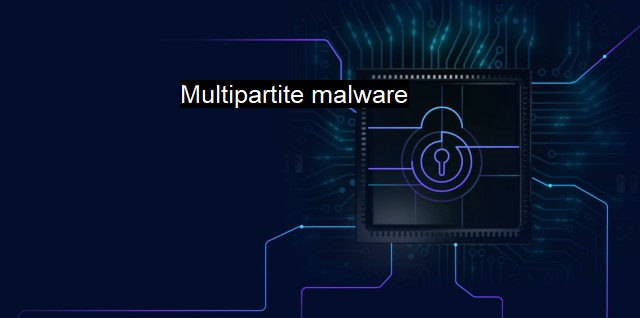What is Multipartite malware?
Understanding the Complexity and Dangers of Multipartite Malware: Threats, Tactics, and Prevention Techniques
Multipartite malware, sometimes also called hybrid malware or compound malware, is a type of malicious software that combines the characteristics of several unwanted or harmful software types to maximize damage and spread rapidly across a network. It is considered one of the most appealing choices for cybercriminals due to its flexibility and multifunctionality.In order to understand multipartite malware, it is beneficial to understand the types of malware it involves, primarily, viruses and worms. Viruses are malicious codes infected files or programs which, when executed, duplicate themselves across files, programs and systems to cause saturation or saturate processing capability. Worms, on the other hand, can be even more harmful as they don't require user execution – they spread across systems by themselves, causing havoc on the network.
Multipartite malware can simultaneously attack both the boot sector and file systems, exploiting the benefits of both viruses and worms. This dual-attack approach makes multipartite malware a double threat and one of the most pernicious risks to computer systems and networks. Once your system is infected, this malware can initiate multiple operations simultaneously, including data deletion, system corruption, and unwanted ad generation, among others.
For instance, if multipartite malware gains access to a system through a security vulnerability, it can immediately replicate itself within the system files while also infecting the boot sector, thereby causing a wide range of damage each time the system boots. By executing attacks on dual fronts, it can deceive traditional security measures and antivirus applications, as they typically look for one type of threat at a time.
In the context of cybersecurity and antivirus software, multipartite malware presents a formidable challenge. It’s regular mutating characteristics make it difficult for conventional antivirus software to locate and isolate them. its ability to infiltrate diverse components of the system hampers attempts at complete removal – often missed sectors or files enable the malware to regenerate, compromising the system all over again.
Against such a persistent threat, continuous vigilance, updates, and a thorough human-operated system check become crucial. Cybersecurity specialists have explored the usage of behavior detection-based security models to counter these threats. Devices such as firewalls and intrusion detection systems are designed to recognize abnormal activities on the network or unusual patterns in the system, thereby aiding in the mitigation of multipartite malware.
Advanced antivirus software capable of automatic updates to match these ever-evolving threats are also available. These involve protective measures like heuristic analysis, which anticipates changes in the malware's code and adjust defensively should it transform. Machine Learning (ML) and Artificial Intelligence (AI) technologies are being increasingly used in this respect, proving to be notable advancements in the field of cybersecurity.
Multipartite malware possesses the formidable ability to infect various system parts simultaneously, using different types of infection. Its hybrid nature, combining virus and worms, makes it a highly dangerous tool that cybercriminals use to exploit security loopholes. Though the rise of multipartite malware presents complex challenges, advancements in cybersecurity measures have ensured continuous development of defensive strategies built to combat the threat. As we continue to counterbalance and respond to the evolving cyber threats, the focus on preventive measures, vigilance, advanced technology, and fostering a holistic awareness amongst the users will become increasingly essential in upholding cybersecurity.

Multipartite malware FAQs
What is multipartite malware?
Multipartite malware is a type of malicious software that combines multiple attack vectors to infect a system. It can spread through various means, such as email, file downloads, or network shares, and it can infect different parts of the system, including files, boot sectors, and memory.How does multipartite malware work?
Multipartite malware uses multiple techniques to exploit system vulnerabilities and gain access to sensitive data. It can infect files in different formats, such as executables, documents, and scripts, and can use different methods to propagate, such as email attachments, drive-by downloads, or social engineering. Once installed, it can perform various malicious activities, such as stealing credentials, encrypting files, or deleting data.How can multipartite malware be detected and prevented?
Multipartite malware can be challenging to detect and prevent because it uses multiple attack vectors and techniques. However, antivirus software can help detect and block known malware signatures, and network security tools can monitor traffic and block suspicious activity. It's also essential to keep systems and software up to date and to educate users about phishing attacks and suspicious links.What are the consequences of multipartite malware?
Multipartite malware can cause significant damage to a system and compromise sensitive data. It can infect multiple files and spread across the network, making it challenging to contain and remove. It can also disable antivirus software and other security measures, making it more challenging to detect and prevent future attacks. The consequences of a multipartite malware infection can range from loss of data to financial and reputational damage.| | A | | | B | | | C | | | D | | | E | | | F | | | G | | | H | | | I | | | J | | | K | | | L | | | M | |
| | N | | | O | | | P | | | Q | | | R | | | S | | | T | | | U | | | V | | | W | | | X | | | Y | | | Z | |
| | 1 | | | 2 | | | 3 | | | 4 | | | 7 | | | 8 | | |||||||